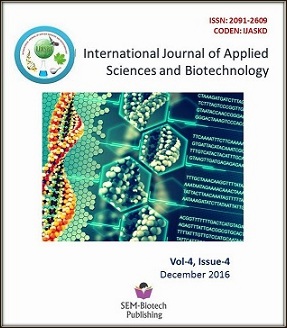Ectopic Overexpression of Barley PIP2;4 Confers Salt Tolerance in Arabidopsis
DOI:
https://doi.org/10.3126/ijasbt.v4i4.16254Keywords:
Aquaporin, PIP2, 4, Overexpression, Barley, ArabidopsisAbstract
In the present study HvPIP2;4 was overexpressed in Arabidopsis thaliana to engineer enhanced salt tolerance. Barley Aquaporin was selected since barley shows fairly good tolerance to drought, salt stress and low temperature compared to many other crops including rice, and it was thought that analysis of barley aquaporin will provide a good insight into the molecular mechanisms involved in transport of water & their efficacy during abiotic stress condition. Arabidopsis line expressing HvPIP2;4 from annual crop plant Hordeum vulgare (Barley) under the control of constitutive promoter was used to analyze the expression of HvPIP2; 4 and its efficacy during salt stress when NaCl concentration gradually increased. The pattern of expression of HvPIP2; 4 were found to be NaCl dose dependent during salt stress. The constitutive expression of HvPIP2;4 enhanced salt stress tolerance in Arabidopsis. HvPIP2;4 played a dominant role in improving plant salt tolerance. It may be very well presumed that overexpression of HvPIP2;4 in crop plant might benefit them by enhancing their salt tolerance capacity.
Int J Appl Sci Biotechnol, Vol 4(4): 498-512
Downloads
985
698




